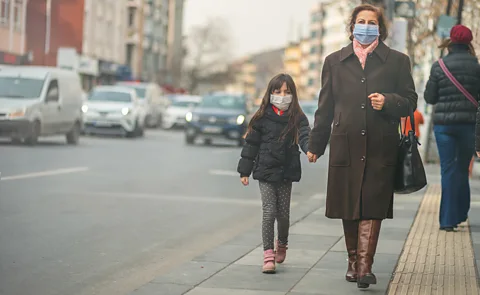How air pollution is causing girls to get their first periods earlier


New research shows that girls in the US are getting their first periods earlier. Exposure to toxic air is partly to blame.
By David Cox

Getty Images
From when girls experience their first period, something which scientists term the age of menarche, to commencing breast development, these seminal changes marking the onset of adolescence appear to be taking place progressively sooner.
The same trend has also been noted around the world. South Korean scientists have described with some alarm how the number of girls displaying signs of precocious puberty – either breast development or menstruation before the age of eight – increased 16-fold between 2008 and 2020.
“We’re also seeing that these decreasing ages at puberty are even more pronounced in lower socioeconomic status groups, and ethnic minority groups,” says Audrey Gaskins, an associate professor at Emory University in Atlanta, the US. “This has important implications for long-term health.”
Researchers like Gaskins are primarily concerned that beginning puberty earlier might trigger a cascade of events which have far-reaching consequences later in adulthood. Emerging data suggests that it may not only curtail the fertility window, particularly if these women then enter menopause sooner, but shorten their lives. Precocious puberty has been repeatedly associated with a higher risk of diseases ranging from breast and ovarian cancers, metabolic syndromes such as obesity and type 2 diabetes, and cardiovascular disease.
Scientists are still trying to understand why this is the case, but Brenda Eskenazi, professor of public health at University of California, Berkeley, says one theory suggests that if the body’s cells are exposed to circulating levels of sex hormones such as oestrogen for a greater period of time, this can increase the risk of tumour development because these hormones stimulate cell growth.
“There’s some theories that having a longer window of exposure to hormones increases risk for reproductive cancers,” she says.

Getty Images
Then there are the possible social consequences. Eskenazi points out that girls who enter puberty earlier are also more likely to become sexually active earlier. “There’s a scary situation in the United States when we have the trend of abortion becoming illegal and contraception not being available,” she says. “It’s going to lead to more unwanted teen pregnancies, so that confluence of factors is very frightening.”
From obesity to air pollution
The onset of puberty is dictated by two wide-reaching communication networks in the body known as the hypothalamic-pituitary-adrenal (HPA) and hypothalamic-pituitary-gonadal (HPG) axes. They connect a region of the brain called the hypothalamus which regulates various essential bodily functions from hunger to temperature control, with different hormone-secreting glands.
Gaskins says that until 10 to 20 years ago, scientists assumed that the sole cause of premature puberty was childhood obesity, with proteins produced by fat cells called adipokines playing a role in stimulating the HPA and HPG axes. “It’s only recently that people have been like, ‘Oh that doesn’t explain it all, and there have to be other factors involved,'” she says.
Instead, a number of studies in the past three years have pointed to another, more surprising cause – air pollution.
Much of this research has been done by scientists in South Korea, with Seoul, Busan and Incheon ranking among the world’s top 100 most polluted cities according to the IQAir index. A recently published review from Ewha Womens University in Seoul identified a repeated relationship between exposure to various pollutants and earlier onset of puberty.
Perhaps an even bigger concern is fine particulate matter (PM), particles which are far too small to see, but are released into the air from sources ranging from construction sites to wildfires, power generation plants, vehicle engines and even dusty, unpaved roads. In October 2023, Gaskins and colleagues found that US girls exposed to high amounts of PM2.5 – defined as particles with a diameter of less than 2.5 μm – and PM10, both in their mother’s womb and during childhood, are more likely to have their first period at an earlier age.
“PM2.5 particles can enter the bloodstream pretty readily,” says Gaskins. “You inhale them into your lungs, and they’re not filtered out like some of the bigger particles would be, and they can then reach different organs. We’ve seen certain PM2.5 particles accumulating in the placenta, foetal tissues, the ovaries, they can get everywhere.”

Getty Images
Studies using mixtures of particles found in indoor air samples, have shown that the chemicals contained within these fine particles are capable of interacting with the receptors for various hormones involved in development – particularly androgen and oestrogen. This can potentially trigger a chain reaction which leads to the initiation of puberty.
“That was our primary hypothesis, that the girls who had higher exposure to PM2.5 were also exposed to more chemicals that were either mimicking oestrogen or just generally disrupting that HPA axis and its regular signals, prompting the body to go into puberty earlier,” says Gaskins.
At the same time, there are likely to be many different factors involved in premature puberty. Gaskins suggests that the emerging evidence relating to PM2.5 and other pollutants is just one example of how harmful environmental chemicals can penetrate the body, stimulating far-reaching hormonal changes. (Read more about how unhealthy air changes your body and mind.)
“We’ve seen PM2.5 particles accumulating in the placenta, foetal tissues, the ovaries, they can get everywhere.” – Audrey Gaskins
“Pre-pubertal girls are an interesting group because another major route of exposure to chemicals which disrupt hormonal processes is through personal care products,” says Gaskins. “And there’s now a lot of companies actively going after that demographic and marketing products to them.”
Overall, Eskenazi says that there is still much we don’t know about the complex connection between our changing world and how these fluctuations are impacting child development, with the role of factors such as microplastics and even climate change being very much unknown.
“I think we’re still just at the tip of the iceberg,” she says. “We don’t know how a hotter climate is affecting the menstrual cycle or even the role of social factors, pressurising girls to grow up sooner. But this trend is very real, and it could be a multifactorial combination of environmental chemicals, obesity and psychosocial issues which are combining to lower the age of menarche.”
SDGs, Targets, and Indicators Analysis:
1. Which SDGs are addressed or connected to the issues highlighted in the article?
- SDG 3: Good Health and Well-being
- SDG 5: Gender Equality
- SDG 11: Sustainable Cities and Communities
- SDG 13: Climate Action
The article discusses the early onset of puberty in girls and its potential health implications. This connects to SDG 3, which aims to ensure healthy lives and promote well-being for all at all ages. The article also mentions that the trend of early puberty is more pronounced in lower socioeconomic status groups and ethnic minority groups, highlighting the issue of gender inequality (SDG 5). Furthermore, the article mentions air pollution as a contributing factor to early puberty, linking it to SDG 11, which focuses on creating sustainable cities and communities. Lastly, air pollution is also connected to SDG 13, which addresses climate action and aims to combat climate change and its impacts.
2. What specific targets under those SDGs can be identified based on the article’s content?
- Target 3.4: By 2030, reduce by one-third premature mortality from non-communicable diseases through prevention and treatment and promote mental health and well-being.
- Target 5.6: Ensure universal access to sexual and reproductive health and reproductive rights as agreed in accordance with the Programme of Action of the International Conference on Population and Development and the Beijing Platform for Action and the outcome documents of their review conferences.
- Target 11.6: By 2030, reduce the adverse per capita environmental impact of cities, including by paying special attention to air quality and municipal and other waste management.
- Target 13.2: Integrate climate change measures into national policies, strategies, and planning.
Based on the article’s content, the identified targets are directly related to the SDGs mentioned above. Target 3.4 focuses on reducing premature mortality from non-communicable diseases, which can be influenced by early puberty and its associated health risks. Target 5.6 emphasizes the importance of ensuring access to sexual and reproductive health, which includes addressing issues related to early puberty. Target 11.6 highlights the need to improve air quality in cities, considering its impact on health and well-being. Lastly, target 13.2 emphasizes the integration of climate change measures into policies and planning, including addressing the role of air pollution in early puberty.
3. Are there any indicators mentioned or implied in the article that can be used to measure progress towards the identified targets?
- Indicator 3.4.1: Mortality rate attributed to non-communicable diseases
- Indicator 5.6.1: Proportion of women aged 15-49 years who make their own informed decisions regarding sexual relations, contraceptive use, and reproductive health care
- Indicator 11.6.2: Annual mean levels of fine particulate matter (e.g., PM2.5 and PM10) in cities (population-weighted)
- Indicator 13.2.1: Number of countries that have communicated the establishment or operationalization of an integrated policy/strategy/plan which increases their ability to adapt to the adverse impacts of climate change and foster climate resilience and low greenhouse gas emissions development in a manner that does not threaten food production
The article does not explicitly mention specific indicators, but the identified targets can be measured using the indicators listed above. These indicators provide a quantitative way to assess progress towards the targets, such as measuring mortality rates attributed to non-communicable diseases (indicator 3.4.1), tracking the proportion of women making informed decisions about reproductive health (indicator 5.6.1), monitoring levels of fine particulate matter in cities (indicator 11.6.2), and assessing the establishment of policies/strategies/plans to address climate change impacts (indicator 13.2.1).
4. Table: SDGs, Targets, and Indicators
| SDGs | Targets | Indicators |
|---|---|---|
| SDG 3: Good Health and Well-being | Target 3.4: By 2030, reduce by one-third premature mortality from non-communicable diseases through prevention and treatment and promote mental health and well-being. | Indicator 3.4.1: Mortality rate attributed to non-communicable diseases |
| SDG 5: Gender Equality | Target 5.6: Ensure universal access to sexual and reproductive health and reproductive rights as agreed in accordance with the Programme of Action of the International Conference on Population and Development and the Beijing Platform for Action and the outcome documents of their review conferences. | Indicator 5.6.1: Proportion of women aged 15-49 years who make their own informed decisions regarding sexual relations, contraceptive use, and reproductive health care |
| SDG 11: Sustainable Cities and Communities | Target 11.6: By 2030, reduce the adverse per capita environmental impact of cities, including by paying special attention to air quality and municipal and other waste management. | Indicator 11.6.2: Annual mean levels of fine particulate matter (e.g., PM2.5 and PM10) in cities (population-weighted) |
| SDG 13: Climate Action | Target 13.2: Integrate climate change measures into national policies, strategies, and planning. | Indicator 13.2.1: Number of countries that have communicated the establishment or operationalization of an integrated policy/strategy/plan which increases their ability to adapt to the adverse impacts of climate change and foster climate resilience and low greenhouse gas emissions development in a manner that does not threaten food production |
Copyright: Dive into this article, curated with care by SDG Investors Inc. Our advanced AI technology searches through vast amounts of data to spotlight how we are all moving forward with the Sustainable Development Goals. While we own the rights to this content, we invite you to share it to help spread knowledge and spark action on the SDGs.
Fuente: bbc.com

Join us, as fellow seekers of change, on a transformative journey at https://sdgtalks.ai/welcome, where you can become a member and actively contribute to shaping a brighter future.







